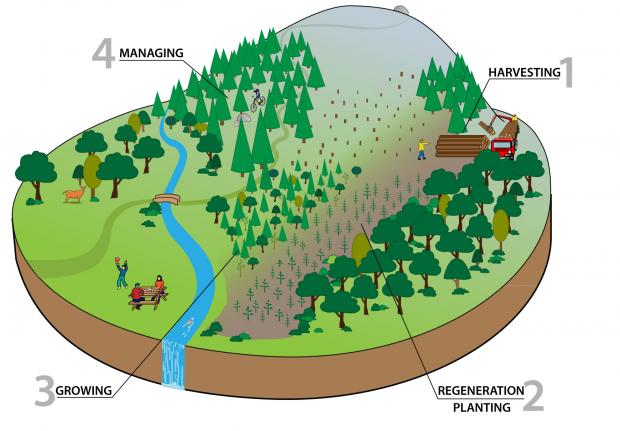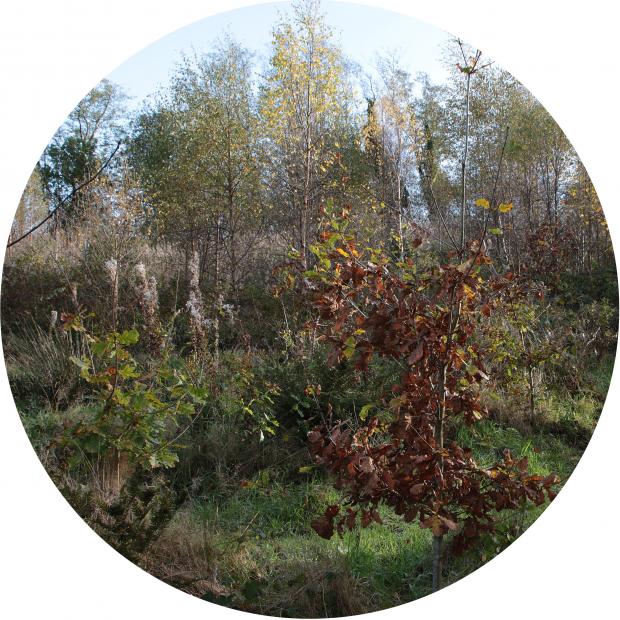Rostrevor Forest
Felling of trees affected by Phytophthora ramorum
Trees in Rostrevor forest, showing discoloration of foliage, have been diagnosed with a plant disease caused by a fungus-like pathogen called Phytopthora ramorum. It affects predominantly larch within forests but is not restricted to larch. This disease has been confirmed throughout the UK and Ireland since 2010.


Further information on:
Frequently Asked Questions
-
Why are some trees in Rostrevor Forest showing discolouration of foliage?
Trees at Rostrevor forest, showing discolouration of foliage, have been infected by Phytophthora ramorum. This is an algae-like organism called a water mould. It has been confirmed as affecting over 150 plant species, including some forest species. It affects predominantly larch within forests but is not restricted to larch.
-
Can it be contained within the boundary of Rostrevor Forest?
Ramorum disease was confirmed in larch trees for the first time in Northern Ireland (NI) in August 2010 and has been confirmed in forests in all counties of NI since then. Research and evidence confirm that the disease can be spread readily though air-borne transmission.
-
What caused the disease and from where did it originate?
Phytophthora ramorum was identified for the first time in NI in rhododendron plants in the nursery trade in late 2002. Since 2010 the disease has been confirmed in larch tree populations in Great Britain and NI, following a similar pattern to its spread throughout the European continent and USA.
-
What area of Rostrevor Forest is affected at present?
Approximately 150 hectares of Rostrevor forest has a larch component and therefore susceptible to the disease, however not all trees within this area are identified as diseased.
-
How widespread is it likely to become?
As above, the areas with larch trees present are subject to the further spread of the disease. While not all larch trees are displaying symptoms at present, all larch trees have the potential to become infected over a longer period.
-
Is the Forest Service intending to directly intervene to stop its spread?
Due to the nature of the disease and its capacity to spread including through aerial transmission, Forest Service management plans for the area focus on the removal of identified affected areas where necessary and the subsequent regeneration of any cleared sites.
Forest plans are reviewed periodically. The planning review for Down Forestry Planning Area, which includes Rostrevor Forest, has been initiated. The consultation was launched on 22 September and ends on 30 November 2022. -
What plans do Forest Service have to deal with this disease?
Plans for the prioritised and phased felling of affected trees will be developed as part of the forest plan and will be presented for consultation with stakeholders.
-
Will any programme of tree felling affect the public access to the forest and the council managed pathways and roads within it?
Forest Service will engage with key stakeholders such as the Council and their recreation providers, users and the public to inform planning for any necessary felling to ensure minimal impact to public use of the forest. As with all harvesting and haulage operations the public will need to be re-directed temporarily from immediate felling sites for safety reasons.
-
What types of machines will be used?
During the works we will be using different types of equipment to cut down and move the trees on site. Some of the trees will be felled by harvester, and then moved off site by the forwarder while some may be chipped / mulched on site and the products removed from site by lorry.
-
Why are you closing the paths during the works?
In order for us to make sure that everyone is kept safe, it is essential for us to close off different areas within the forest. This will be done to try and minimise disruption to users and we will provide diversion routes where possible.
-
What will it look like during and after the works?
Due to the nature of the works there will be some temporary damage to the ground surface in the areas where we will be working and to path edges along the route timber will be removed from site. We will work with the contractor on site to minimise this damage by building brash roads and carefully choosing extraction routes. Once the felling is completed we will undertake work to repair excessive damage where appropriate. The site will be left as tidy as possible with the removal of as much wood as possible with stumps cut low to the ground.
-
What happens after the trees are cut down?
Following the removal of the trees a programme of replanting felled areas will be carried out complying with the forest design and regeneration plans which are currently under review. The Phytophthora response will not result in deforestation. Once areas of the forest have opened up again it is still important for users to wash boots, paws, wheels and bikes after a visit to site to reduce the risk of spreading the disease to other areas.
-
Will the planned operations impact on the Rostrevor Oakwood SAC and or the ancient / veteran oak trees in Rostrevor Forest?
As a competent authority, Forest Service complete Habitat Regulations Assessments where operations are planned which have the potential to impact on a SAC. Operations will be planned and carried out in a manner to minimise any potential impacts on the Rostrevor Wood SAC or veteran oak trees in the wider forest area. While operations are planned and ongoing, Forest Service also plan to take the opportunity to undertake improvement works to maintain and protect the veteran oak trees within the wider forest area. The advanced felling of the infected trees also provides opportunity to implement the forest design plan which introduces more native woodland in the forest, including in the area surrounding the SAC.
-
What impact will the felling of these areas have on the landscape?
Forest plans in the Down planning area are currently under review and subject to stakeholder engagement and comment. In developing the plans Forest Service undertake visual assessments of the forests from key viewpoints in the surrounding countryside. This helps to determine the potential influence forest management decisions such as these could have on the landscape.
-
There appears to be a major tree felling programme underway by Coillte on the side of Slieve Foye on the opposite side of Carlingford Lough, is this directly related to what is happening in Rostrevor?
Ramorum disease has been confirmed throughout the UK and Ireland. Forest Service representatives engage with the Department of Agriculture, Food and the Marine (DAFM) and Coillte colleagues in relation to the progress of the disease. Coillte gave advance public notice of tree felling works to remove diseased trees at Slieve Foye Recreation Site. Harvesting and haulage operations have recently been undertaken.
-
What can I do to help?
In order to help prevent the spread of the disease we are asking all site users to follow our information about cleaning footwear, bikes, kit and dogs paws after a visit to the forest.
